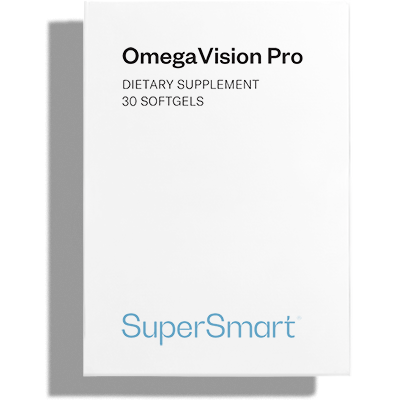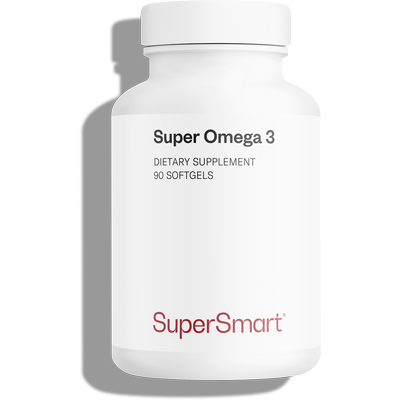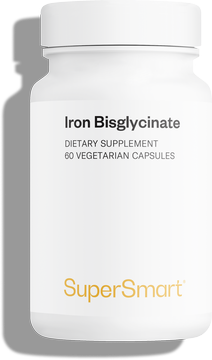A US study points to the link between omega-3s and visual health after the age of 40
Everyone knows that eyesight tends to decline with age. But a new American study highlights the potential protective role of omega-3s on the retina. A new way of preserving vision after the age of 40.

The retina, macula and ageing eyes: understanding the basics of vision
Clear, precise vision depends on the proper functioning of several eye structures, the most essential of which is the retina. Lining the back of the eye, this thin light-sensitive membrane contains photoreceptor cells responsible for transmitting images to the brain.
At the centre of the retina is the macula, a tiny but crucial area. It is responsible for central vision, and the perception of fine detail and colour.
However, as we age, the retina suffers the effects of oxidative stress, inflammation and cellular degradation (like many other tissues in the body). These phenomena can affect the quality of vision, especially in individuals over the age of 50.
One of the main diseases linked to this ageing process is AMD (age-related macular degeneration). This is a progressive disease of the macula, which can lead to reduced visual acuity, blurred vision or loss of central vision.
Faced with these symptoms, researchers have for several years been exploring the potential protective role of certain nutrients in visual health, including the well-known omega-3s (1-3).
Omega 3 and the retina: what a recent American study shows
A 2024 study by a team of American researchers examined the link between omega-3s and retinal health in elderly people with age-related macular degeneration (4).
Promising results for the protection of ocular tissues
The study found that participants who regularly consumed long-chain omega-3s, in particular DHA (docosahexaenoic acid) and EPA (eicosapentaenoic acid), showed slower progression of AMD than those who consumed little.
The researchers point out that these polyunsaturated fatty acids could help protect eye tissue against chronic inflammation and oxidative stress, two key factors in retinal ageing.
Omega-3s, and DHA in particular, could therefore play a protective role against damage to the macula, the central area of the retina.
The study highlights the potential role of omega-3s as a nutritional support to be incorporated into an overall strategy to prevent retinal ageing.
DHA: a recognised aid to vision
A major structural component of the retina (5), DHA helps to maintain normal vision. It is involved in the fluidity of cell membranes and the optimal functioning of photoreceptors.
Several research studies suggest that DHA:
- may play an important role in preserving the integrity of retinal cells, particularly when they are exposed to intense light or high metabolic activity (6);
- may also be involved in anti-inflammatory mechanisms, via the production of compounds known as resolvins and protectins (7);
- could help limit intracellular oxidative stress, while supporting the protection of mitochondria within visual cells (8).
These different effects could help to slow the progressive damage to the macula generally observed with advancing age, particularly in the case of AMD.
How to increase your omega-3 intake naturally (and protect your eyesight)
To take advantage of the potential benefits of omega-3s for visual health, it is essential to consume them regularly. If your dietary intake is not sufficient, you can opt for targeted supplementation.
Eat foods rich in omega-3s
To support your vision and naturally enrich your omega-3 intake, you can include the following in your diet:
- vegetable oils: walnut oil, rapeseed oil, soya oil, linseed oil, etc.
- nuts and seeds: flaxseeds, walnuts, chia seeds, etc.
- oily fish: mackerel, sardines, wild salmon, herring, cod, anchovies, etc.
- seafood: prawns, mussels, etc.
Supplement with omega-3-rich food supplements
It is sometimes difficult to achieve the necessary intake to fully benefit from omega-3s' effects on vision, particularly for people who eat little seafood or vegetable fats.
In these cases, food supplements based on purified and concentrated omega-3s offer a simple and effective solution to meet those needs.
![]() Discover Super Omega 3, a concentrated fish oil for an optimum supply of marine omega-3 fatty acids.
Discover Super Omega 3, a concentrated fish oil for an optimum supply of marine omega-3 fatty acids.
When the main objective is to support visual health, it is particularly beneficial to choose a dietary supplement that is very rich in DHA.
![]() Discover Super DHA, a formula concentrated in DHA from pure fish oil, designed to maximise the supply of the main omega-3 to the retina.
Discover Super DHA, a formula concentrated in DHA from pure fish oil, designed to maximise the supply of the main omega-3 to the retina.
Combining the right nutrients for overall eye protection
In addition to omega-3s, eye health after the age of 40 can also rely on other protective micronutrients:
- lutein and zeaxanthin, carotenoids found in high concentrations in the retina;
- plants rich in anthocyanins (grape skin, black carrot, red radish), flavonoids shown to improve ocular blood circulation and protect the retina;
- zinc, an essential trace element that helps maintain normal vision and cognitive function;
- vitamin E, an essential antioxidant that protects cells against oxidative stress, which can damage the retina and accelerate eye ageing;
- vitamin B2, which helps to maintain normal vision by protecting eye cells against oxidative stress, and can help to reduce visual fatigue;
- vitamin A, which helps maintain normal vision.
![]() Discover OmegaVision Pro, an advanced complex formulated for eye health and vision which combines several ingredients: DHA, lutein, zeaxanthin, zinc and vitamins.
Discover OmegaVision Pro, an advanced complex formulated for eye health and vision which combines several ingredients: DHA, lutein, zeaxanthin, zinc and vitamins.
SUPERSMART ADVICE
References
- Downie LE, Ng SM, Lindsley KB, Akpek EK. Omega-3 and omega-6 polyunsaturated fatty acids for dry eye disease. Cochrane Database Syst Rev. 2019 Dec 18;12(12):CD011016. doi: 10.1002/14651858.CD011016.pub2. PMID: 31847055; PMCID: PMC6917524.
- Pan M, Zhao F, Xie B, Wu H, Zhang S, Ye C, Guan Z, Kang L, Zhang Y, Zhou X, Lei Y, Wang Q, Wang L, Yang F, Zhao C, Qu J, Zhou X. Dietary ω-3 polyunsaturated fatty acids are protective for myopia. Proc Natl Acad Sci U S A. 2021 Oct 26;118(43):e2104689118. doi: 10.1073/pnas.2104689118. PMID: 34675076; PMCID: PMC8639353.
- Querques G, Souied EH. The role of omega-3 and micronutrients in age-related macular degeneration. Surv Ophthalmol. 2014 Sep-Oct;59(5):532-9. doi: 10.1016/j.survophthal.2014.01.001. Epub 2014 Jan 27. PMID: 24657038.
- Li K, Liu J, Li X, Liu X, Hu P, He M. Association of EPA and DHA with age-related macular degeneration: a cross-sectional study from NHANES. Front Med (Lausanne). 2024 Sep 4;11:1440479. doi: 10.3389/fmed.2024.1440479. PMID: 39296908; PMCID: PMC11408175.
- Jeffrey BG, Weisinger HS, Neuringer M, Mitchell DC. The role of docosahexaenoic acid in retinal function. Lipids. 2001 Sep;36(9):859-71. doi: 10.1007/s11745-001-0796-3. PMID: 11724458.
- SanGiovanni JP, Chew EY. The role of omega-3 long-chain polyunsaturated fatty acids in health and disease of the retina. Prog Retin Eye Res. 2005 Jan;24(1):87-138. doi: 10.1016/j.preteyeres.2004.06.002. PMID: 15555528.
- Bazan NG. Cell survival matters: docosahexaenoic acid signaling, neuroprotection and photoreceptors. Trends Neurosci. 2006 May;29(5):263-71. doi: 10.1016/j.tins.2006.03.005. Epub 2006 Apr 3. PMID: 16580739.
- Cousin SP, Hügl SR, Wrede CE, Kajio H, Myers MG Jr, Rhodes CJ. Free fatty acid-induced inhibition of glucose and insulin-like growth factor I-induced deoxyglucose uptake in 3T3-L1 adipocytes: evidence for involvement of reactive oxygen species. J Biol Chem. 2001;276(38):35442–35451.
Keywords
5 Days
The products I use are excel·lent
The products I use are excel·lent
ROSAS Josep Maria
13 Days
Delivery is prompt and I never saw a…
Delivery is prompt and I never saw a quality problem with the manufacturing. It is not possible to assess efficacy on a personal basis, since too many factors come into play. Efficacy can only be assessed statistically with a sufficient number of cases.
Roger De Backer
14 Days
I collaborates with the Supersmart…
I collaborates with the Supersmart more than 10 years. Every thing is going good. Quality of the things is good. Delivery comes in time. Five stars definitely !!!
Oleksiy
15 Days
All good
Simple, frictionless site, easy ordering, good delivery updates and execution.
Chris Robbins
17 Days
I feel better
I feel better
Peter Ammann
17 Days
Prompt delivery
Prompt delivery
JAKUB Radisch
18 Days
My new go-to for top quality supplements!
I am buying more and more of my supplements from this superb, high quality company. Cannot recommend it enough. Plus, excellent customer service with a quick, helpful team and speedy deliveries. Highly recommend Supersmart!
Cecilie H.
22 Days
SUPERSMART WHAT ELSE👍
SUPERSMART WHAT ELSE👍
DIEDERLE Christophe
25 Days
Excellent quality products with…
Excellent quality products with innovative formulas, as someone who has been suffering with acid reflux, these supplements have been lifesavers.
Oriana Moniz
25 Days
high quality supplement!
high quality supplement!
GALANT
25 Days
Good service prompt delivery
Good service prompt delivery
Mrs Marcella Reeves
30 Days
I like your clear explanation
I like your clear explanation. And how to make a choice of products for a specific health problem
Ingrid
37 Days
Great product and it arrives quickly.
Great product and it arrives quickly.
SOMMARIVA Gianni
38 Days
Excellent products and fast service.
Excellent products and fast service. What do we need more?
Margarida
42 Days
The variety of products is amazing
The variety of products is amazing, the offers are good and the sending is very fast. I just miss having a bit more of guidance about combinations, possible interactions, etc.
Maria Angeles Verdu








